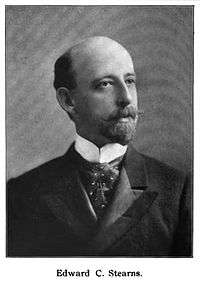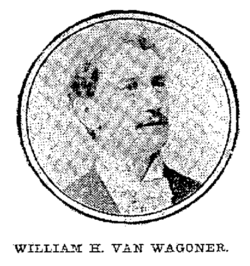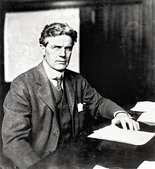Notable citizens of Syracuse, New York
The following people were notable citizens of Syracuse, New York or made contributions to the history of the city.
Some of the notable members of the city circa 1823 at the time of incorporation were the likes of John Rogers, owner of John Rogers & Company and George Davis of George Davis & Company. In 1825, during the first village election, John Rogers was trustee, James Webb was assessor and Henry Young, a miller, was poundmaster. By 1826, John Wall and Joel Owen were the first fireman. In 1828, Calvin Riley was a soap maker and by 1829, George T. M. Davis, merchant, built a house at the corner of Onondaga and South Avenue, on the "cinder road." In 1830, Caleb Davis owned a butcher shop.[1]
Notable figures
| Name | Birth | Death | Occupation | Notable contribution | |
|---|---|---|---|---|---|
| Frederick C. Brower | 1851 | July, 1931 | Locksmith, inventor, businessman. Introduced the telephone to Syracuse. | He brought the telephone to the city in 1878 after seeing the device exhibited at the Philadelphia Exposition of 1876 and secured the rights for Central New York from the Bell system.[2] | |
| Alexander T. Brown | November 21, 1854 | January 31, 1929 (age 74) | Engineer, inventor, businessman and founder of Brown-Lipe Gear Co. and Brown-Lipe-Chapin Co. | During his life he was considered one of the "captains of industry" in Syracuse and was credited with over 300 patents and 100 inventions; among them the Smith Premier typewriter and the pneumatic tire.[3] He was one of the founders of the Brown-Lipe Gear Company, a manufacturer of bicycle gears and later Brown-Lipe-Chapin Company, a manufacturer of automobile gears, differentials and transmissions, which merged with General Motors.[4] |  |
| DeWitt Clinton | March 2, 1769 | February 11, 1828 (age 58) | Former Senator and sixth Governor of New York State | He was largely responsible for the construction of the Erie Canal. From 1810 to 1824, he was a member of the Erie Canal Commission. He was among the first members, appointed in 1810, who projected and surveyed the route to be taken. After 1816, he became the driving force during the construction of the canal.[5]| |  |
| Asa Danforth | July 6, 1746 | September 2, 1818 (age 72) | Early settler, built a grist mill and sawmill that contributed to the growth of Onondaga County. | He was a leading citizen of Onondaga County, New York where he was the second white man to settle after he arrived in 1788. He was persuaded to relocate from Montgomery County by Ephraim Webster, the first white man to settle in Onondaga. He built a local grist mill and helped settle the area.[6] | |
| Asa Danforth Jr. | June 29, 1768 | c.1821 | Early settler, land speculator, highway engineer | He was one of the first citizens of Onondaga County, New York when he arrived there with his father, Asa Danforth in 1788.[6] Danforth incurred heavy debts speculating in land in New York State. Hoping to reverse his fortunes, he invested in the especially risky land titles of nearby Upper Canada and later was a highway engineer.[7] | |
| Herbert H. Franklin | September 1, 1866 | July 7, 1956 (age 89) | Automobile manufacturer and company founder and president | He bought the original patent for "hydrostatic moulding process" and was the first in the machine die-casting process in the world. He was founder of H. H. Franklin Manufacturing Company and Franklin Automobile Company. a manufacturer of luxury automobiles in Syracuse from 1902-1934.[8] | |
| James Geddes | July 22, 1763 | August 17, 1838 (age 75) | Engineer, Surveyor, New York State legislator and U.S. Congressman | He was instrumental in the planning of the Erie Canal and other canals in the United States. He was also at the forefront of development of the salt industry at Onondaga Lake near Syracuse, New York beginning in 1794. The town of Geddes, New York was named for him.[9] |  |
| Theodore E. Hancock | May 30, 1847 | November 19, 1916 (age 69) | American lawyer and politician | In 1889, he was elected District Attorney of Onondaga County and served from 1890-1892.[10] |  |
| Harvey A. Moyer | 1853 | October 9, 1935 (age 82) | Carriage and automobile manufacturer and company founder and president | He founded the H. A. Moyer Carriage Company in Syracuse, New York in the 1876 with only $20 in his pocket. The company later changed assembly to luxury automobiles in 1908 and was renamed to H. A. Moyer Automobile Company.[11] The company manufactured 100 automobiles a year until they ceased production in 1914. Moyer also owned a working dairy farm called Moyerdale in Liverpool, New York and was a Holstein-Friesian cattle breeder.[12] |  |
| Bert E. Salisbury | May 28, 1870 | October 20, 1946 (age 76) | Businessman, inventor and entrepreneur | He was president of Onondaga Pottery Company (O.P.Co.), later renamed to Syracuse China in 1913 and president and general manager of Pass & Seymour, Inc.[13] | |
| C. Hamilton Sanford | May 28, 1873 | February 16, 1942 (age 68) | Automobile magnate, businessman, banker and co-founder of Sanford-Herbert Motor Truck Company | He was co-founder of Sanford-Herbert Motor Truck Company and president of the Syracuse Trust Company,[14] which was renamed to Marine Midland Trust Company of Central New York in January 1953, and Marine Midland Bank in 1971. By 1999, the bank changed its name to HSBC Bank USA.[15] | |
| Horatio Seymour | May 31, 1810 | February 12, 1886 (age 75) | 18th Governor of New York from 1853 to 1854 and from 1863 to 1864. | He was born in Pompey Hill in Onondaga County and as governor, won approval of a measure to finance the enlargement of the Erie Canal via a $10.5 million loan in a special election in February 1854 which contributed to the growth of Central New York.[16] His family owned large tracts of Westend property. Seymour Street in Syracuse was named after him. The name was suggested by Seymour's good friend, Henry Gifford, a prominent salt maker.[17] |  |
| Edward C. Stearns | July 12, 1856 | April 21, 1929 (age 72) | Founder of hardware concern E. C. Stearns & Company, E. C. Stearns Bicycle Agency, Stearns Steam Carriage Company | He worked with his father, George N. Stearns in the hardware business and inherited his father's company which he renamed E. C. Stearns & Company. By the mid-1890s, he branched into bicycle manufacturing and formed a subsidiary called E. C. Stearns Bicycle Agency. Stearns, ever innovative, moved to automobile production and built his first automobile in 1899, an electric. The automobile firm sold so few models through 1900 that they reverted to steam power in 1901. The Stearns enterprise was known as Wholesale Bi-steam Carriage Company and Stearns Automobile Company which was also called Stearns Steam Carriage Company.[18] |  |
| Comfort Tyler | February 22, 1764 | August 5, 1827 (age 63) | Contributed his engineering skills to the development of Central New York | He was one of the original settlers of modern Syracuse, New York brought his family in the spring of 1788 to what became the hamlet of Onondaga Hollow on the future Seneca Turnpike, south of the city's center today. He joined Asa Danforth and Ephraim Webster, the first whites to settle there, who had obtained permission to live there from the Onondaga (tribe). Tyler built the more ambitious house in Onondaga Hollow and contributed his engineering skills to the development of Central New York.[19] |  |
| William Van Wagoner | April 1870 | Bicyclist, auto designer and businessman | He was born in New Jersey[20] and was a bicycle racer from 1888 through the mid-1890s and won many competitions throughout the Northeastern United States. He went on to design the Van Wagoner, an American electric automobile manufactured between 1899 and 1903 by the Syracuse Automobile Company.[21] |  | |
| Ephraim Webster | June 30, 1762 | October 16, 1824 (age 62) | Represented the Onondaga nation in several land treaties with New York State. | He was the first white settler in the Central New York area later named Syracuse. He arrived in 1786 searching for the "wilderness" and quickly adapted to the region and lifestyle of the Onondaga nation. For three decades, the Onondagas trusted and relied on him more than any other white man. Webster was a translator and acted as an agent for the Onondagas on several land transactions with New York State.[22] | |
| John Wilkinson (American colonist) | November 13, 1758 | 1802 (age 43) | Early pioneer from Rhode Island, settled in Skaneateles, New York | He was a direct descendant of Lawrence Wilkinson who fled the oppression of Oliver Cromwell in 1652 and emigrated to America[23] and the son of Roger Wilkinson, an early colonist, who settled in Rhode Island where Roger Williams (theologian) offered a startling new concept, freedom of religion.[24] Son, John Wilkinson Jr. was the first Postmaster of Syracuse, New York and gave the city its name. Great-grandson, John Wilkinson invented the air-cooled engine.[24] | |
| John Wilkinson (Syracuse pioneer) | September 30, 1798 | September 19, 1862 (age 63) | Lawyer and first Postmaster of village of Syracuse | Wilkinson was an original town planner and helped lay out and name the village streets. He took inspiration from a poem about an ancient city and named the new village, Syracuse just in time for the opening of the Erie Canal.[25] |  |
| John Wilkinson (Franklin automobile) | February 11, 1868 | June 25, 1951 (age 83) | Chief engineer and vice-president of Franklin Automobile Company. | Wilkinson invented the air-cooled engine for the Franklin automobile. Grandson of city planner, John Wilkinson (Syracuse pioneer) and great-grandson of John Wilkinson (American colonist).[24] |  |
See also
References
- ↑ Bannan, Theresa. Pioneer Irish of Onondaga: (about 1776-1847). The Knickerbocker Press, New York, 1913. Retrieved October 23, 2010.
- ↑ "Automobile Spurred Growth of Central N.Y. Industry". Farber and Associates, LLC 2009-2011. January 10, 1984.
- ↑ Fitch, Charles Elliott. Encyclopedia of biography of New York, Volume 5. The American Historical Society, 1916. Retrieved August 5, 2011.
- ↑ "Alexander Brown House". Syracuse Now and Then, 2011. Retrieved August 5, 2011.
- ↑ Edwin G. Burrows "Little Short of Madness," American Heritage, Winter 2010.
- 1 2 "Plan to Place More Tablets To Mark Spot Where First White Settler Lived". Syracuse Herald. Syracuse, New York. September 12, 1915.
- ↑ Gates, Lillian F. "Asa Danforth". University of Toronto/Université Laval, 2000. Retrieved September 6, 2010.
- ↑ "A Man and an Automobile - The Story of Herbert Franklin". Syracuse Herald-Journal. Syracuse, New York. April 19, 1956.
- ↑ "Rich in Tradition, Village of Geddes Recalls Many Events as It Marks the 99th Anniversary of Its Incorporation". Syracuse Herald, April 19, 1931, Section 2, Pgs. 6 & 10. Retrieved 2010-08-24.
- ↑ "The Political Graveyard". Lawrence Kestenbaum, 2010. Retrieved September 7, 2010.
- ↑ "Directory of American Tool and Machinery Patents". Datamp, 2003-2010. Retrieved 2010-08-02.
- ↑ "Moyer Heritage - Love for Autos Runs in Family". Syracuse Post-Standard. Syracuse, New York. March 16, 1966.
- ↑ Reed, Cleota & Skoczen, Stan. Syracuse China. Syracuse University Press, 1997. Retrieved 2010-08-20.
- ↑ "Funeral Services Are Held For C. Hamilton Sanford". Syracuse Herald Journal. Syracuse, New York. February 17, 1942.
- ↑ "New York Bank History". Scripophily.com, 2010. Retrieved September 12, 2010.
- ↑ Mitchell, Stewart (1938). Horatio Seymour of New York. Cambridge, Massachusetts: Harvard University Press, p. 33.
- ↑ "Syracuse Names". The Post-Standard. Syracuse, New York. Sep 18, 2003.
- ↑ "1900 Stearns Electric". Early American Automobiles, 2010. Retrieved December 31, 2010.
- ↑ "Know Your City Parks" (PDF). Baltimore Woods Nature Center, Marcellus, New York, 2010. Retrieved 2010-08-13.
- ↑ "1900 Census in Syracuse, New York". United States Census Bureau, 1900.
- ↑ David Burgess Wise. The New Illustrated Encyclopedia of Automobiles. Atlantic, 1992.
- ↑ McAndrew, Mike. "First a friend, then a foe". The Post-Standard, Syracuse, N.Y., August 11, 2000.
- ↑ Seely, Hart (August 27, 2002). "From Old Bones, A Family Story". Syracuse Post-Standard. Syracuse, New York.
- 1 2 3 "Revolutionary War veteran's son gave city its name". Syracuse Post-Standard. Syracuse, New York. August 27, 2002.
- ↑ Fitch, Charles Elliott. Encyclopedia of biography of New York. The American Historical Society, New York, N.Y., 1916, pg. 123.
External links
 Media related to People from Syracuse, New York at Wikimedia Commons
Media related to People from Syracuse, New York at Wikimedia Commons
This article is issued from Wikipedia - version of the 10/12/2016. The text is available under the Creative Commons Attribution/Share Alike but additional terms may apply for the media files.